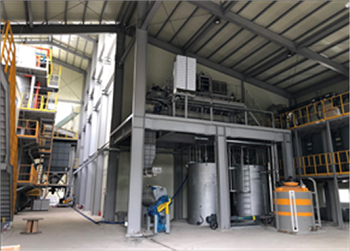The Ministry of Land, Infrastructure and Transport (Minister Byun Chang-heum) and the Korea Institute for Land, Infrastructure and Transport Science and Technology Promotion (KAIA, Director Son Bong-su) construct a’urban resource recycling complex plant that combines municipal wastes, such as household waste, food waste, and sewage sludge, and recycles them as energy. Technology (hereinafter referred to as resource recycling technology) was developed.
The resource recycling technology is a complex plant technology that can recycle three kinds of wastes as fuel, such as △living waste, △food waste, and sewage sludge by linking basic environmental facilities and energy production and supply facilities. It is the core technology of the Korean low-carbon city model for the transition to a distributed urban energy supply and demand system in a wide area.

This technology development was promoted as an R&D project by the Ministry of Land, Infrastructure and Transport from June 2016 to November 2020, and 12 public institutions and companies such as the Institute of Advanced Technology (host organization) and GS E&C participated in the development. It is significant in that it has completed performance verification through trial operation and secured operational technology, and advanced technology level by developing core facilities such as hydrothermal carbonization, drying, and incineration as domestic technology. A total of 12.9 billion won was invested in technology development, including 3.4 billion won for the private sector and 9.5 billion won for the government.
In the meantime, municipal wastes have been individually installed and operated on the ground by incineration facilities, landfill facilities, recycling sorting facilities, and sewage treatment facilities to treat household waste according to their type, and environmental complaints due to the occurrence of odors in the waste treatment process. This is being raised continuously.
Through the development of this resource recycling technology, various kinds of waste can be collected in one place and produced as energy through a complex plant, opening a way to solve environmental and energy problems. In addition, high-concentration odors, which are limited in treatment in the odor removal facility, are collected separately and used as combustion air required for the energy conversion process to completely burn them, thereby completely treating odors.
This is the first in Korea, and there are cases of complex treatment of two types of waste, such as household and food waste, in foreign countries, but there is no case of complex treatment of three types.
 The urban resource recycling technology demonstration facility was installed in the metropolitan landfill site so that three kinds of waste can be transported and utilized at the same time to supply heat energy to the nearby Dream Park CC Club House.
The urban resource recycling technology demonstration facility was installed in the metropolitan landfill site so that three kinds of waste can be transported and utilized at the same time to supply heat energy to the nearby Dream Park CC Club House. Dream Park CC is a 460,000 pyeong public golf course (2 club houses, 36 holes) built in the Seoul Metropolitan Area Landfill in Seo-gu, Incheon, and is a facility managed and operated by the Metropolitan Area Reclamation Management Corporation.
As a result of supplying energy to the Dream Park CC Club House through a complex plant made with resource recycling technology, energy costs were reduced by 330 million won per year, and treatment costs by 30% compared to the cost of treating each of the three wastes. It turned out to be possible. Disposing of wastes of 7,000 households (based on population of 20,000) costs about 322.4 million won, but it is reduced to 233.2 million won when using a complex plant.
In addition, if 7,000 households use 22.6 tons of waste, such as 14 tons of household waste, 4.8 tons of food waste, and 3.8 tons of sewage sludge, 550 households can become energy independent and reduce greenhouse gas (CO₂) emissions of 2,466 tons per year. It was demonstrated. Specifically, △surplus energy production of 17.04Gcal/day △energy production sales profit of 730 million won/year △energy self-reliance 550 households △greenhouse gas reduction effect of 2,466tCO₂/year.
Lee Sang-ju, director of technology and safety policy at the Ministry of Land, Infrastructure and Transport said, “In the future, basic environmental facilities will be able to be promoted in a safer and more efficient small-scale decentralized type using advanced technology. It will be used as a supply facility and the ground space can be used as a variety of convenience facilities.”
He then emphasized, “It can be used for urban innovation, smart city construction, and new city construction, and it is expected to play a large role in overseas order-taking activities.”
